Layman D. Biology Demystified: A Self-Teaching Guide
Подождите немного. Документ загружается.

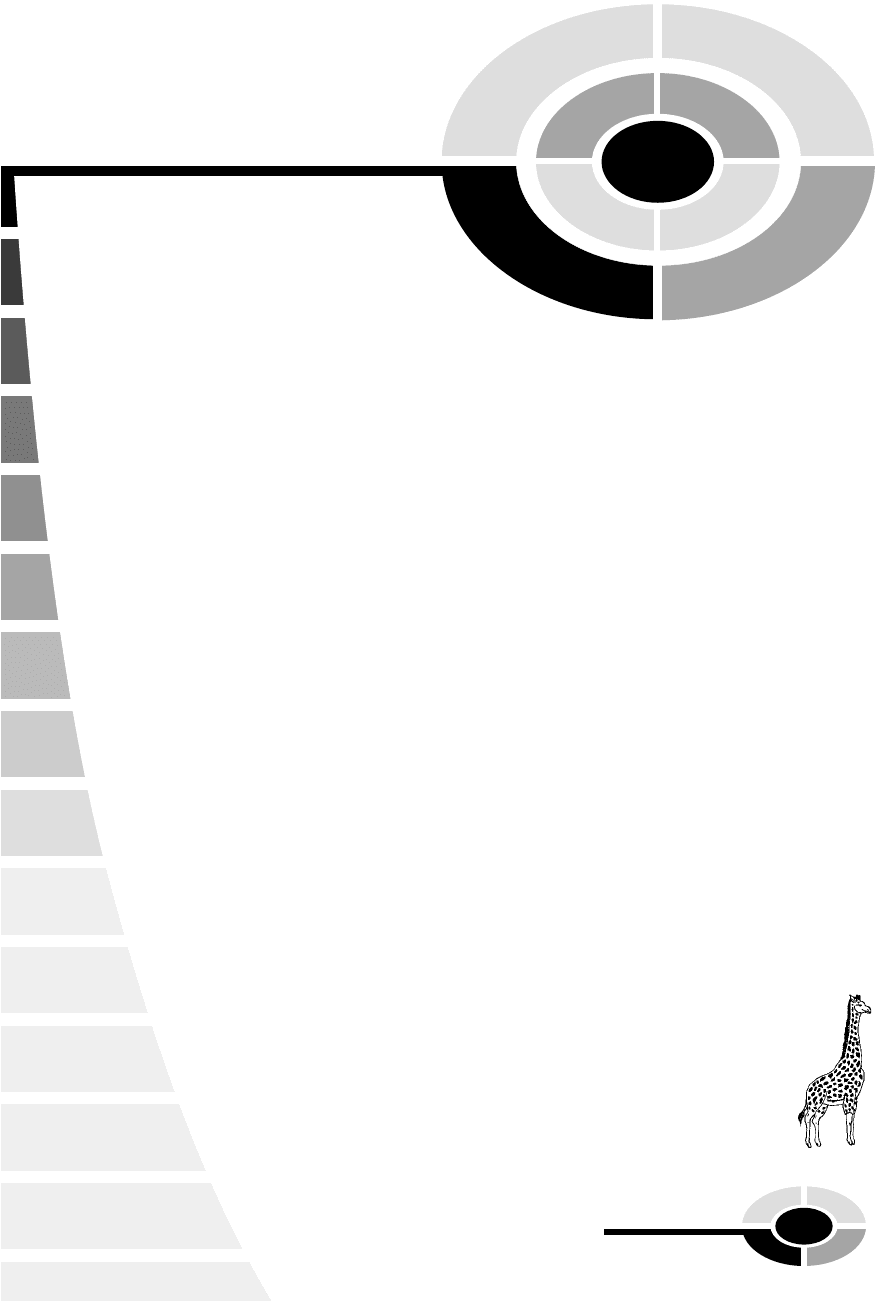
[13:25 13/6/03 N:/4058 LAYMAN.751/4058-Alltext.3d] Ref: 4058 Layman: Biology Demystified All-text Page: 217 1-388
217
CHAPTER
13
Skins and Skeletons
Having introduced and characterized the mammals, it is now appropriate for
us to further examine the meaning of the following claim: ‘‘Oh, those pesky
animals! They’re just a bag of bones!’’ Yes, this is true! The ‘‘bag’’ is their
surrounding skin, while the ‘‘bones’’ are the major organs making up their
skeletons.
Yet, there is also another reason why we consider both the skin and the
skeleton together, here in Chapter 13. Recall (Chapter 10) that in all animals,
except for sponges, there are two or more germ layers within the embryo.
These germ layers are technically called derms or ‘‘skins,’’ since they consist of
thin groups of primitive cells that progressively differentiate (dih-fer-EN-she-
ate) or ‘‘become more different,’’ as the embryo undergoes its development. In
the hollow gastrula and later stages of embryonic development, there are three
derms or skins. Remember that Chapter 10 identified these as the endoderm
(inner skin), mesoderm (middle skin), and ectoderm (outer skin).
The ectoderm eventually forms much of the skin, hair, nails, the enamel of
the teeth, and the most important portions of the nervous system. The meso-
derm, in contrast, ultimately gives rise to the bones, muscles, much of the
heart and circulatory system, and the connective tissues. We consider skin
and skeleton together in the same chapter because they arise from two adja-
cent germ layers within the embryo.
1, Order
Copyright 2003 by The McGraw-Hill Companies, Inc. Click Here for Terms of Use.

Skins and Skeletons: Tough Reminders of a
Former Life
But the final reason we lump them together is due to the answer to the
following question: ‘‘When you are out walking in the woods or fields, and
you come upon the remains of a long-dead animal, what part of the body is
usually left for you to identify?’’ Certainly, the two most prominent (and
perhaps toughest) parts of the dead animal are its covering of skin (with
maybe attached fur or feathers) on the outside, and its bony skeleton lying
within. Indeed, paleontologists (scientists who study ancient life) most fre-
quently use skeletal remains – teeth, and (if they’re very lucky) fragments of
preserved hide or skin – to help them identify and classify long-dead or
extinct animals. Thus, we study skin and bones together, because that’s all
what is usually left after an animal dies!
‘‘Ain’t We Just Peachy?’’: The Skin as Our
Integument
‘‘How is the human body like a peach?’’ In reply to this odd question, you
might comically retort, ‘‘Well, we’re just a bunch of fruits!’’ But more ser-
iously, both a peach and the human body are surrounded by an integument
(in-TEG-you-ment) – a thin ‘‘covering.’’ And lying deep to this integument is
a much thicker layer of flesh. Hence, it is the integument or ‘‘skin’’ (derm)
that encloses and protects the flesh.
And the skin or integument of both the peach and the human body has an
outermost layer, the epidermis. You might remember from our study of
plants (Chapter 9) that the epidermis is literally ‘‘(something) present upon
the skin,’’ and that in ferns and seedbearing plants (such as peach trees), the
epidermis is an extremely thin layer of outer protective cells. But from here,
the similarity between peach integument and human integument begins to
fade (Figure 13.1).
KERATINIZED EPITHELIAL STRATA
One key difference between the epidermis of humans and most other animals,
from those of plants, is the presence of keratin. This ‘‘horn substance’’
[13:25 13/6/03 N:/4058 LAYMAN.751/4058-Alltext.3d] Ref: 4058 Layman: Biology Demystified All-text Page: 218 1-388
PART 4 Anatomy and Physiology of Animals
218
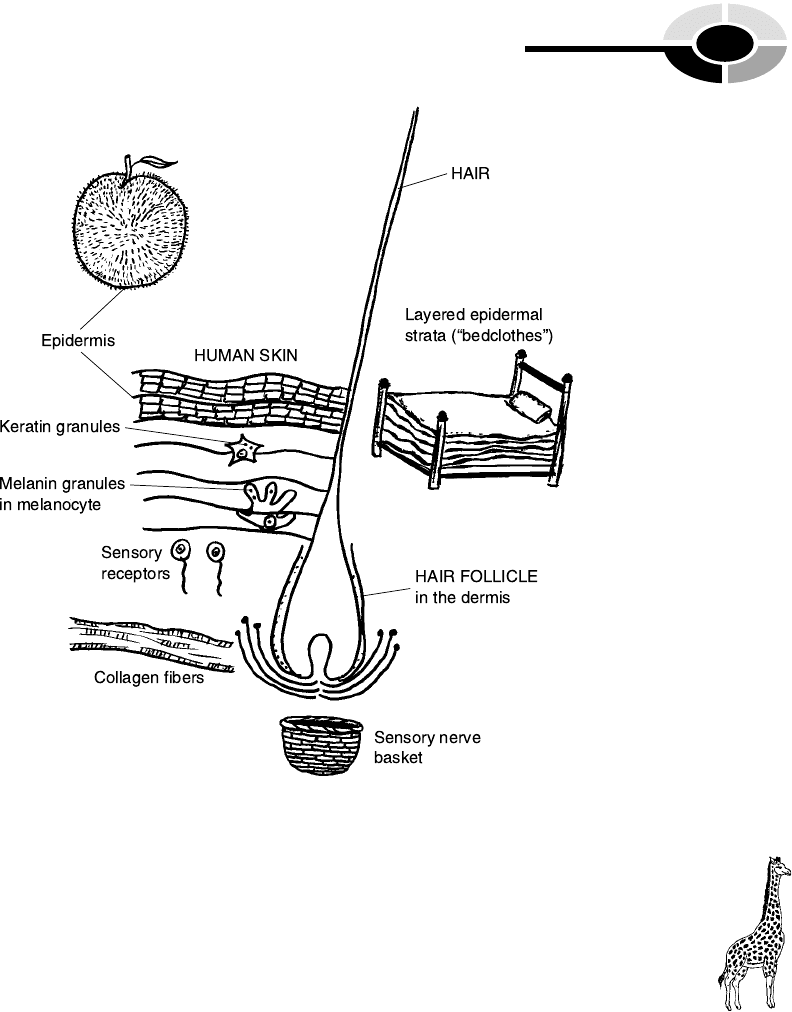
[13:25 13/6/03 N:/4058 LAYMAN.751/4058-Alltext.3d] Ref: 4058 Layman: Biology Demystified All-text Page: 219 1-388
(Chapter 12) is found in the epidermis and hair and nails of humans, as well
as in the claws and horns of various other animals. Since keratin is essentially
waterproof, so is human skin. Our epidermis consists of a multiple series of
thin, overlapping strata (STRAT-uh) of keratinized epithelial cells. When
viewed under a light microscope, this highly orderly arrangement gives the
epidermis the appearance of a collection of thin ‘‘layers or bed covers’’
(strat), heaped one upon the other over a bed.
The outer surface stratum (STRAT-um) is really not living, at all! Rather,
it consists of a series of stacked squamae (SKWAY-me) – dead, keratin-
stuffed ‘‘scales’’ (squam). This means that you and I face the world with
dead scales (squamae) showing at our body surface! But this has the definite
advantage of protecting us from dirt, fungi, and bacteria, which cannot easily
penetrate the multiple layers of lifeless squamae.
CHAPTER 13 Skins and Skeletons 219
Fig. 13.1 Anatomy of the human skin: Not just a peach!
2, Order
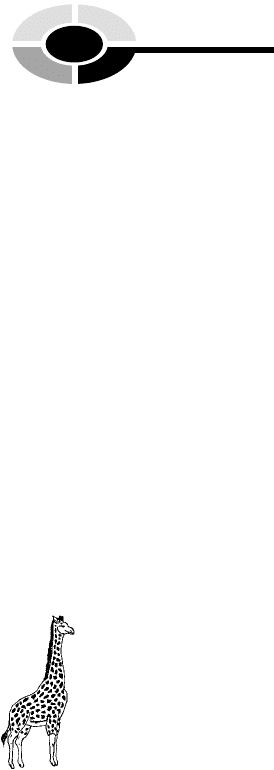
SKIN COLORATION BY MELANIN
In addition to containing keratin, the epithelial cells in our epidermis are also
rich in melanin (MEL-uh-nin) or ‘‘black’’ (melan) ‘‘substance’’ (-in). Melanin
is a brownish-black pigment produced by melanocytes (MEL-uh-nuh-sights).
These ‘‘black cells’’ are large, octopus-shaped cells with several long arms of
cytoplasm. After they produce the melanin granules, the melanocytes appear
to penetrate the membranes of adjacent cells, and inject some of their mel-
anin granules into them. This results in a darkening of the epidermis.
Melanin’s chief function is absorption of ultraviolet (ul-truh-VEYE-uh-lit)
rays that strike the surface of the skin. These ultraviolet (UV) rays are
invisible rays whose wavelengths lie ‘‘beyond’’ (ultra-) those of X-rays, but
below those of visible violet light. The benefits are dual: reduction in the risk
of suffering skin cancer (due to mutation of skin cell DNA by UV light), and
reduction in skin wrinkling.
THE DERMIS AS OUR TOUGH MAIN ‘‘SKIN’’
True to its name, the epidermis literally lies ‘‘upon’’ (epi-) the dermis (DER-
mis). The dermis is the main, fiber-rich, connective tissue portion of the skin.
The dermis is especially rich in a dense network of collagen (CALL-uh-jen)
fibers. The word collagen translates to mean ‘‘glue’’ (coll) ‘‘producer’’ (-gen).
Collagen fibers are thick, tough, unbranched fibers that have a high tensile
(TEN-sil) strength; that is, they have a great ability to resist pulling or ‘‘ten-
sion’’ (tens) forces. [Study suggestion: Place two fingers on the skin of your
forearm. Now, gently try to stretch your skin between your fingertips. Feel
the resistance to stretching, the tensile strength, that is being exerted? This
glue-like function is mainly the result of the thousands of collagen fibers
running like a tough, woven basket throughout your dermis.]
One important type of structure found within the dermis is the hair follicle
(FAHL-uh-kul). As evident from Figure 13.1, the hair follicle is a ‘‘little bag’’
lined by a membrane, and containing a hair. The base of the hair follicle lies
in the dermis. The hair, itself, is basically a flexible rod of tightly packed,
keratin-stuffed squamae. Arranged around the base of the hair follicle is a
sensory nerve basket.[Study suggestion: Without touching your skin, gently
stroke the hairs on your forearm. What do you feel – a tickling, tingling
sensation? This reveals the main function of hairs: touch sensations.]
There are many other types of sensory receptors located within the dermis.
Besides receptors for the sense of touch, there are those for pressure, pain,
cold, heat, and vibration.
[13:25 13/6/03 N:/4058 LAYMAN.751/4058-Alltext.3d] Ref: 4058 Layman: Biology Demystified All-text Page: 220 1-388
3, Order
PART 4 Anatomy and Physiology of Animals
220
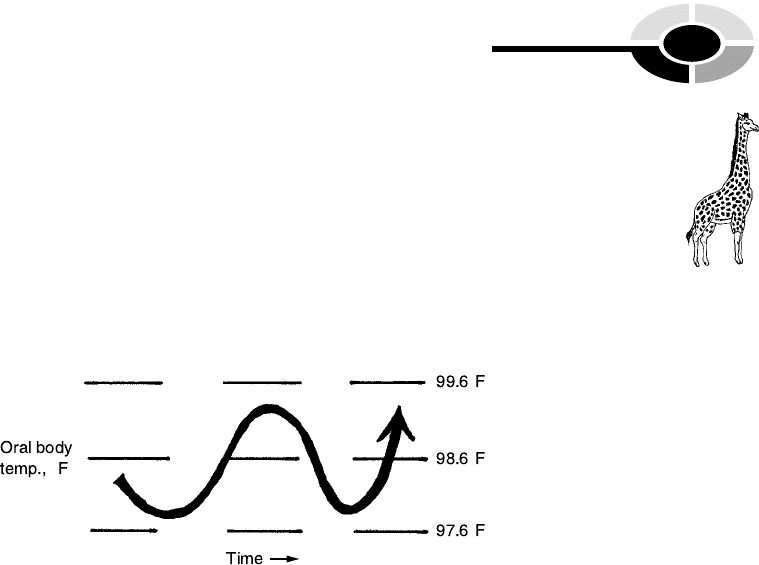
One of the most critical functions of the dermis is its role in thermoregula-
tion (THER-moh-reg-you-LAY-shun). By thermoregulation, we mean the
‘‘regulation’’ or control of ‘‘heat’’ (therm): specifically, the control of internal
body temperature. Way back in Chapter 1, we talked about the homeostasis
or relative constancy of oral body temperature, measured in units of degrees
Fahrenheit. This homeostasis (relative constancy) of oral body temperature is
another term for thermoregulation. It was represented symbolically by an
S-shaped curve shown back in Figure 1.2 (A):
Figure 13.2 reveals what happens when the oral body temperature of a
human or other homeothermic animal rises towards the upper limit of its
normal range. (This temperature boost often occurs during heavy exercising.)
In the dermis, two critical events kick in. The sweat glands increase their
secretion of sweat into the sweat ducts, which then moves up and out onto
the surface of the skin through sweat pores. The excess body heat essentially
boils the watery sweat from the skin surface, causing it to evaporate into the
air. This net heat loss helps to lower the oral body temperature.
A second chain of physiological events involve vasodilation (vase-oh-die-
LAY-shun) – the ‘‘process of ’’ (-tion) blood ‘‘vessel’’ (vas) ‘‘widening’’ (dilat).
As the body gets hotter, the blood vessels in the dermis vasodilate (vase-oh-
DIE-late), becoming wider. This allows more hot blood to circulate from the
deep core of the body, and flow more freely into the vessels of the skin.
Much more heat is then lost by radiation, the movement of heat waves or
rays from the hot blood in the skin out into the cooler air surrounding the
body.
By both of these means combined (increased evaporation from sweat þ
increased heat loss by radiation from the blood), oral body temperature is
eventually brought back down to its average, long-term level (about 98.6
degrees Fahrenheit in most human beings). And thermoregulation, or home-
ostasis of oral body temperature, is thereby achieved.
CHAPTER 13 Skins and Skeletons 221
[13:25 13/6/03 N:/4058 LAYMAN.751/4058-Alltext.3d] Ref: 4058 Layman: Biology Demystified All-text Page: 221 1-388
°
°
°
°
4, Order
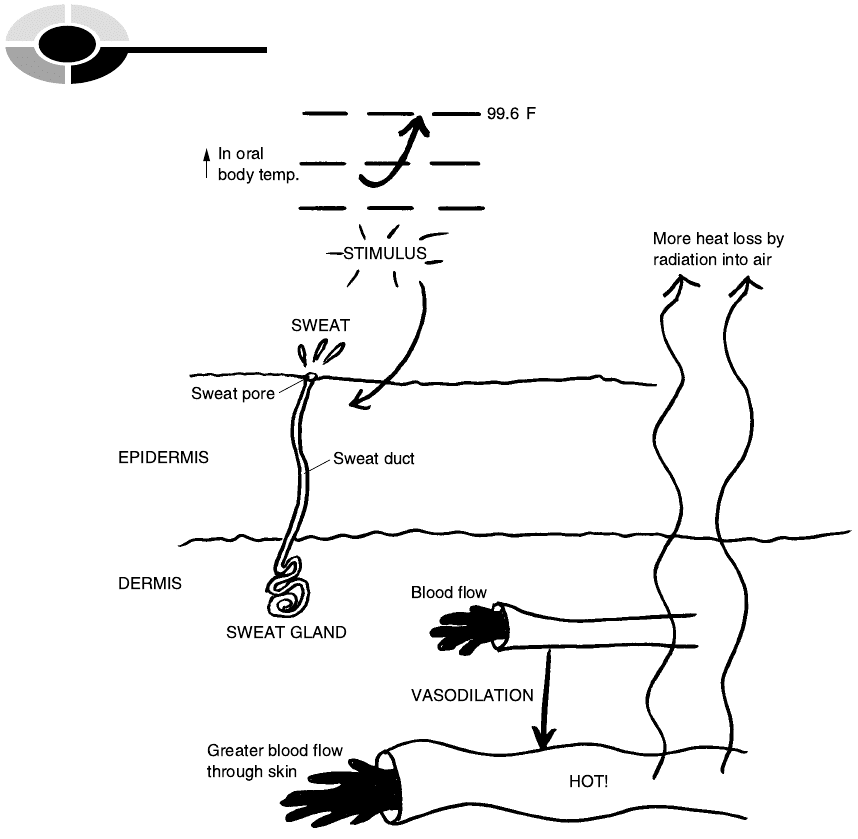
Hyperthermia or Hypothermia: Body Heat Out
of Control!
The high degree of Biological Order of body temperature shown within
Figure 13.2 could formally be called a state of normothermia (nor-moh-
THER-me-uh). Literally, normothermia is ‘‘a condition of ’’ (-ia) ‘‘normal’’
(normo-) body ‘‘heat’’ (therm). Because thermoregulation is proceeding so
successfully, oral body temperature does go up and down over time, yet it
still remains between a low of about 97.6 degrees F and a high of approxi-
[13:25 13/6/03 N:/4058 LAYMAN.751/4058-Alltext.3d] Ref: 4058 Layman: Biology Demystified All-text Page: 222 1-388
PART 4 Anatomy and Physiology of Animals
222
°
Fig. 13.2 Thermoregulation: Keeping our body heat within range.
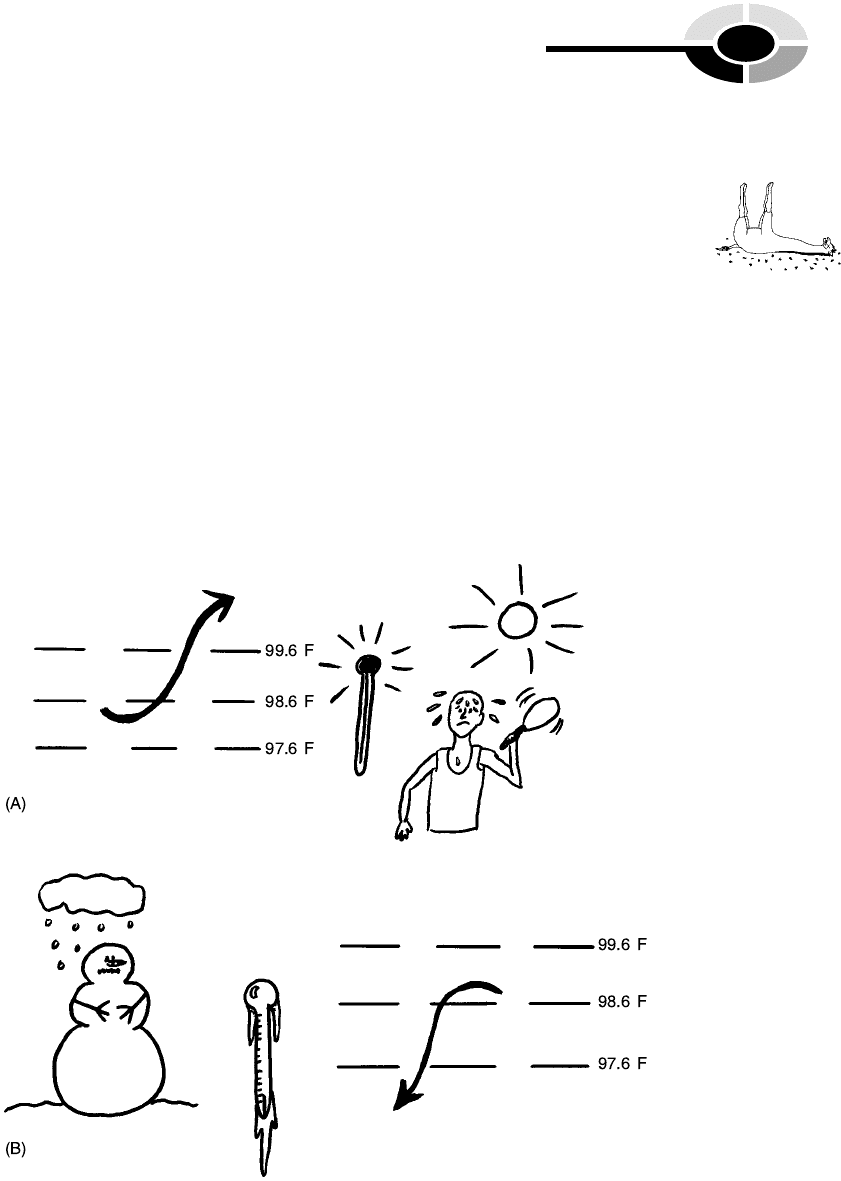
mately 99.6 degrees F. Thus, there is a homeostasis of oral body temperature,
such that it remains within its ‘‘normal’’ (normo-) range over time. The
person remains clinically healthy with regards to body temperature.
Now consider, in marked contrast, the abnormal conditions illustrated
within Figure 13.3. What happens when oral body temperature rises signifi-
cantly above the upper normal limit of 99.6 degrees F? As displayed in Figure
13.3 (A), the resulting state of Biological Disorder is technically called
hyperthermia (high-per-THER-me-uh). This is ‘‘a condition of excessive or
above normal’’ (hyper-) body heat or temperature. In hyperthermia, the
patient is essentially suffering from a fever. It may be accompanied by such
other familiar symptoms as chills and muscular aches and pains. If breaking
of the normally S-shaped pattern of body temperature homeostasis is severe
enough, then the temperature keeps rising past 108 degrees F, and the person
may go into a coma and die!
Certainly, then, hyperthermia is to be avoided! ‘‘Okay, so let’s drive the
oral body temperature way below its lower normal limit of about 97.6
CHAPTER 13 Skins and Skeletons 223
[13:25 13/6/03 N:/4058 LAYMAN.751/4058-Alltext.3d] Ref: 4058 Layman: Biology Demystified All-text Page: 223 1-388
1, Disorder
°
°
°
°
°
°
Fig. 13.3 Hyperthermia (A) and hypothermia (B): Too much, or too little, of a good thing.
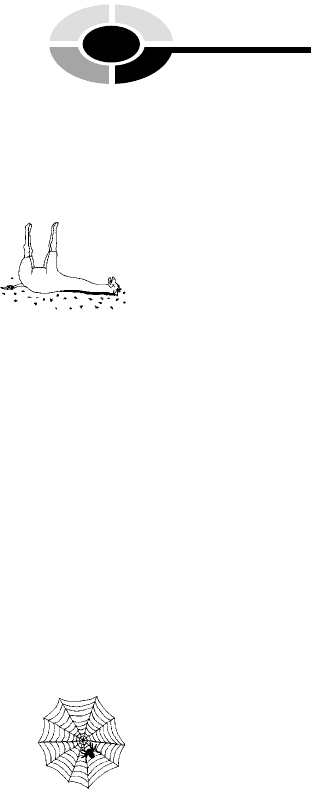
[13:25 13/6/03 N:/4058 LAYMAN.751/4058-Alltext.3d] Ref: 4058 Layman: Biology Demystified All-text Page: 224 1-388
PART 4 Anatomy and Physiology of Animals
224
degrees F!’’ you might helpfully suggest at this point. ‘‘In this way, we won’t
have to worry so much about hyperthermia!’’
But, thinking carefully, are we still not breaking the S-shaped pattern of
thermoregulation or homeostasis? Here, however, the breaking of pattern or
introduction of Biological Disorder is at the low end, rather than the high
end, of the body temperature range. When oral body temperature plunges
significantly below 97.6 degrees F, then a state of hypothermia (high-poh-
THER-me-uh) is said to exist. Hypothermia is a ‘‘deficient or below normal’’
(hypo-) ‘‘condition of ’’ body ‘‘heat.’’ Since it represents temperature going
down to an excessively low level, hypothermia (like hyperthermia), if great
enough, can result in coma and death.
The Human Endoskeleton: Our Hard ‘‘Dried
Body’’ Lying within
If we humans are just a ‘‘bag of bones,’’ then, having discussed the ‘‘bag’’
(skin), we now need to consider the bones! Recollect that crabs, lobsters, and
other arthropods (Chapter 11) have soft bodies that are covered and pro-
tected by a tough exoskeleton of the substance, chitin. The skeleton or ‘‘hard
dried body’’ is on the outside, like a coat of mail or battle armor. Human
beings and most other vertebrates, however, have taken the exactly opposite
approach to these arthropods in protecting their delicate internal organs
from physical trauma and injury. They possess an endoskeleton (EN-doh-
skel-uh-tun), or ‘‘hard dried body within’’ (endo-).
A big peach, in a plant-sense, has its own form of endoskeleton – a rock-
hard inner pit (Figure 13.4). As explained in Chapter 9, a ripened fruit, such
as a nice round, pinkish peach, is actually the fleshy wall of a plant ovary,
which encases and protects the seeds holding the delicate plant embryos. In
peaches, the stony pits are the seeds that contain the early embryos for
germinating new peach trees.
In humans and our animal relatives, the endoskeleton is comprised of
many individual bone organs (and the joints made between them). But
instead of protecting a delicate plant embryo, bones in the skull or cranium
protect the soft eyes and brain. And bones in the thorax or chest wall protect
the relatively soft heart and lungs.
In both the peach and the human body, a very thin, tough integument or
skin ensheaths a large quantity of relatively soft flesh. And lying deep within
this fleshy mass is a protective peach pit or (in the case of vertebrate animals)
a protective endoskeleton.
2, Disorder
1, Web
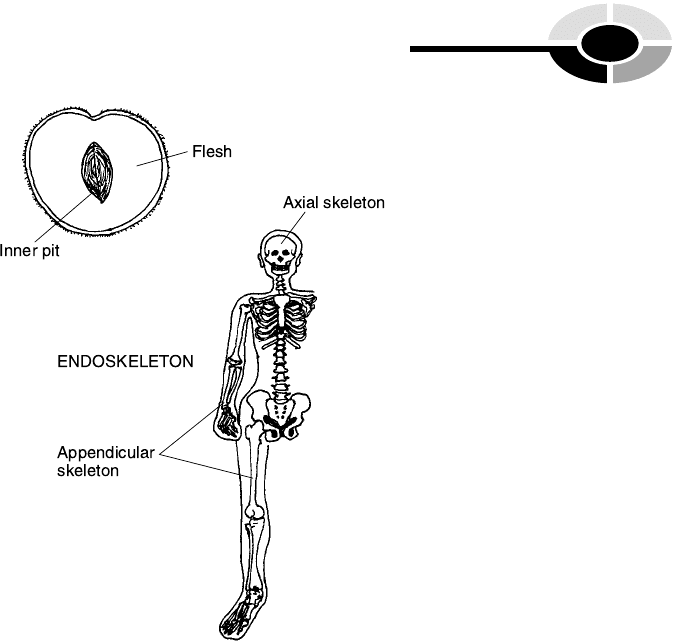
Humans, of course, have a much more complex body plan, compared to
peaches! Our skeleton is subdivided into two main portions. An axial skele-
ton (discussed back in Chapter 12) lies within the head, neck, and body
trunk. Conversely, an appendicular (ah-pen-DIK-you-ler) skeleton lies within
the body appendages (ah-PEN-dah-jes) or limb ‘‘attachments.’’ The appendi-
cular skeleton consists of the bones in the upper appendages (the shoulders,
arms, wrists, and hands), as well as those in the lower appendages (the hips,
legs, ankles, and feet). Taken together, the axial and appendicular skeletons
make up the ‘‘hard dried body’’ or endoskeleton lying ‘‘within’’ us.
And being chordates, our vertebral columns stiffen and support us from
the inside, rather than from the outside.
Anatomy of a Long Bone
To fully understand the skeleton, we must examine the anatomy of a typical
long bone. A long bone is simply a bone that is much longer than it is wide.
Consider, for instance, the ‘‘thigh’’ bone or femur (FEE-mur). As Figure 13.5
CHAPTER 13 Skins and Skeletons 225
[13:25 13/6/03 N:/4058 LAYMAN.751/4058-Alltext.3d] Ref: 4058 Layman: Biology Demystified All-text Page: 225 1-388
Fig. 13.4 Peaches, pits, and the human endoskeleton.

reveals, the femur has a main shaft, called the diaphysis (die-AH-fuh-sis),
which is literally a ‘‘growth’’ (phys) ‘‘through’’ (dia-) the middle of the
bone. And capping each end of the diaphysis (main bone shaft) is an epiphysis
(eh-PIH-fih-sis) – a ‘‘growth’’ (phys) present ‘‘upon’’ (epi-) the shaft.
Most of the long bone is composed of dense or compact bone matrix
(MAY-tricks). This is the white, rock-hard, calcium-rich portion of the
long bone. But in the ‘‘middle’’ (medull) portion of the long bone, we find
the medullary (MED-you-lair-ee) or marrow cavity. This medullary (marrow)
cavity, as its name indicates, contains the yellow bone marrow. The yellow
color of this type of marrow is mainly due to the presence of adipose (AH-
dih-pohs) or ‘‘fatty’’ connective tissue.
Finally, we see the spongy or cancellous (CAN-seh-lus) bone located within
each epiphysis of the long bone. It obviously gets its spongy name from the
existence of numerous holes and an extensive network of cancelli (can-SEL-
eye) – ‘‘little crossbars’’ (cancell) of hard bone matrix. Much like a real
sponge, therefore, spongy (cancellous) bone tissue consists of a network of
cancelli or little crossbars and the many holes between them. Unlike a real
sponge, however, spongy bone tissue contains red bone marrow within its
[13:25 13/6/03 N:/4058 LAYMAN.751/4058-Alltext.3d] Ref: 4058 Layman: Biology Demystified All-text Page: 226 1-388
PART 4 Anatomy and Physiology of Animals
226
Fig. 13.5 General anatomy of a long bone.
